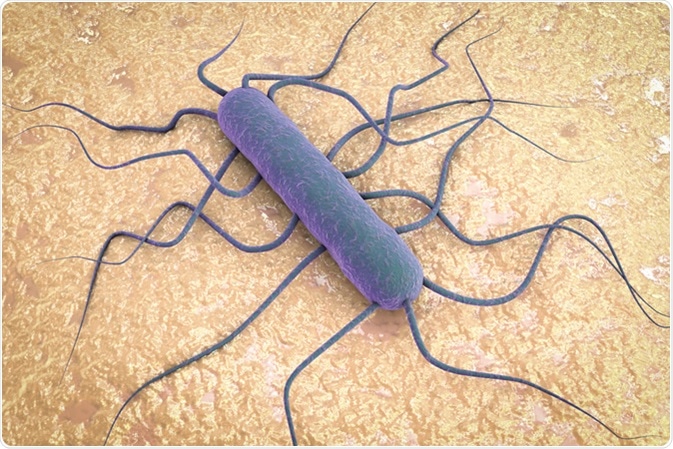Skip to:
As the name suggests, foodborne viruses are those transmitted through the consumption of food and beverages. They are typically highly resistant to environmental factors, such as low pH (acidity) and heat. This makes them highly persistent so that they can remain infective for over a month in food and water. As they originate within the intestines of humans and animals, these viruses are predominantly spread through feces and other body fluids. The contamination of food stuff with pathogenic viruses is often caused by poor hygienic practices in the production line or contact of the food with animal waste or sewage.
Foods most commonly associated with foodborne viruses include shellfish, which are harvested near human sewage outlets, undercooked meats as well as fruit and vegetables which are grown on animal waste fertilized grounds. Even if sewage systems are treated, the virus removal and the removal efficiency depend on how much viral load is present.
Types of foodborne viruses
Gastroenteritis and hepatitis are the most commonly reported syndromes of foodborne viruses. Although many different types of gastrointestinal viruses can be found in humans, gastroenteritis caused by the human norovirus and hepatitis A virus (HAV) are predominantly reported with foodborne viruses. Other viruses including enterovirus, sapovirus, rotavirus, astrovirus, adenovirus and Hepatitis E virus have also been associated with the transmissions through food and water.
Norovirus causes gastroenteritis leading to diarrhoea, vomiting, fever, headaches and abdominal pain. Bacterial causes of gastroenteritis include Campylobacter, which is associated with raw or undercooked food, Salmonella, which is usually found in meat or eggs, and Listeria, which can be present in ready-made food. They cause symptoms such as diarrhoea, vomiting and fever but can also lead to life threatening conditions and death.

Campylobacter jejuni bacteria, 3D Rendering - Illustration Credit: Crevis / Shutterstock
Worldwide, norovirus is the most common cause of acute gastroenteritis. About 1 in 5 cases in developed countries are caused by norovirus. In areas where rotavirus vaccines have been implemented, norovirus is now the most common cause of gastroenteritis in children.
Another common foodborne virus is Hepatitis A, which causes liver inflammation. Symptoms include fever, headache, nausea and vomiting, diarrhea, abdominal pain and jaundice. The virus is responsible for 50% of hepatitis cases and is often self-limiting which means the pathogen clears up or its host dies. However, Hepatitis A virus can rarely cause liver failure (requiring a liver transplant) or death.
Global disease burden of foodborne viruses
Foodborne diseases are major contributors towards the global disease burden. The outbreaks and the associated illnesses not only affect the health of the patients but also increases the costs of the treatment and measures to prevent further outbreaks. The potential of these viruses to spread across borders is immense due to the unrestricted travel conditions in many parts of the world. Therefore, risk assessments in food safety are top priorities to lower the risk of foodborne viruses. Although these viruses are causes of concern for the food industry, some industrialized countries started monitoring foodborne viruses only recently. Due to the lack of appropriate detection methods to quantify the viral load present and the low levels of virus present in food, the risk of spreading remains.
Currently, the only method used in detecting viruses in foods are based on viral nucleic acids and focus on the pathogens of Hepatitis A virus and norovirus. However, these do not indicate if life virus is present. Therefore, for the purpose of risk assessments it becomes difficult to determine whether the detected virus leads to a disease or not as is it not possible to evaluate if the virus remains infective or becomes infective later.
Recent news reported about outbreaks of Listeria caused by deli-sliced meats and cheeses in the US and sandwiches in hospitals in the UK which lead to death of patients, showing the importance of hygiene during the food handling process.

3D illustration of bacterium Listeria monocytogenes, gram-positive bacterium with flagella which causes listeriosis - Illustration Credit: Kateryna Kon / Shutterstock
Can foodborne viruses be avoided?
To avoid the risk and spread of foodborne viruses, food safety and maintaining good hygiene is very important throughout the handling of food items. For example, washing hands and avoiding cross-contamination by using different chopping boards for meats and vegetables can help to stop the viruses from spreading.
Preventing Foodborne Illness: Talking to Patients About Food Safety
Thorough cooking at certain temperatures can also help to kill any viruses present. Raw or undercooked foods are higher at risk of containing foodborne viruses. Additionally, food manufacturers should conduct risk assessments and educate their staff about the risks of poor hygiene during food handling.
References
Further Reading
Last Updated: Sep 10, 2019